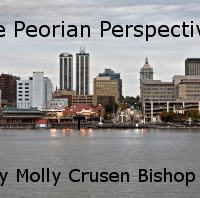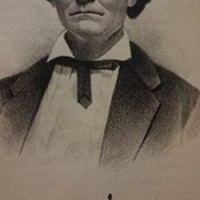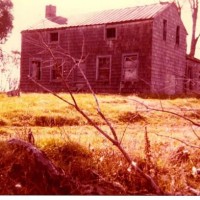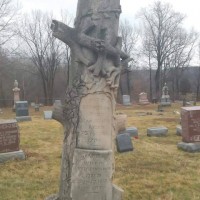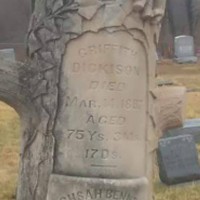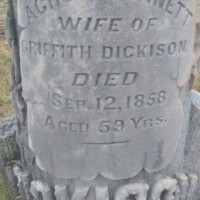Molly Crusen Bishop: Griffith Dickison, true pioneer
- Details
- Published on Friday, 13 January 2017 15:19
- Written by Molly Crusen Bishop
Griffith Dickison was one of Peoria area’s earliest settlers. He was born to farmers in Indiana on Nov. 27, 1811. His education was the real world and real life, and whatever minimal schooling was available during that time period in Switzerland, Indiana.
Despite the lack of a significant formal education Griffith’s intelligence and fortitude were vast. Griffith is a wonderful example of the heartiness of the old settlers to Peoria.
He married Achsah Bennett and had three children. He brought his family here by covered wagon and horses and built a home just outside of Peoria, in Dunlap in 1835. There is still a private family cemetery located on Dickison Cemetary Road in Dunlap, and his family still owns land in the area.
Griffith built the wooden farmhouse overlooking a valley so they would be able to see threats of any groups of Native Americans who could possibly attack Griffith and his family.
Preceding the pioneers in the Peoria area, there was a Black Hawk War between the United States and Native Americans. This involved many local tribes including the Kickapoos, and took place in Illinois in 1832. It generally wasn’t safe for white settlers and there was a movement to push the Indians farther West, and away from this part of the country.
It was difficult for people trying to settle in what was then the western part of the United States and quite often inter-tribal warfare contributed to the danger for the settlers. By the end of the war, many Native Americans retreated to the Mississippi River and this was the beginning of a deluge of new settlers coming from the eastern states. Incidentally, Abraham Lincoln served in the Black Hawk War.
Life in the new frontier was extremely rough. The eastern states had mills and business of all kinds. The new west had little to no establishments to help settlers acquire necessities for survival. They had no knowledge of the local plants, trees or animals and had to work incredibly hard to find their way. Griffith had to find water, food, and resources. His wife had to cook and care for the children. Disease and hunger were daily concerns.
The first gravestone in the historic Dickison Cemetary is for a 4-year-old little girl that came with the Dickison expedition. She died in a prairie fire.
Griffith’s wife Achsah died Sept. 12, 1858. He married Margaret Johnson and had a child and divorced. Little more is known about this portion of his life. He again married, to Sarah Robinson, and had six more children, giving him 10 children.
Griffith made a fortune. At first he owned only a few acres of land, but he turned that into more than one thousand acres of land just outside of Peoria. He later owned much livestock and had even more success in his cattle and through land speculations. Griffith also owned stocks, shares, and bonds in the United States railroads.
He was a self-made man who had a scrupulous reputation and was filled with integrity in his many successful business dealings. It is amazing what the pioneers were able to accomplish in a time when there were no grocery stores or supply stores around. Everything had to be made by their own wits and strength.
If they needed milk, they had to have a cow, and feed and care for the cow. If they needed eggs to eat, they had to have chickens, feed and care for the chickens. They had to find or grow fabrics to make their own clothing and linens, as well. There were no doctors or medicines to heal. If a wagon wheel broke, one would have to cut down a tree and make a new one. They had to grow their own fruit and vegetables, as well.
Life was difficult at best, and these people were true testaments to the spirit of the human being.
Griffith Dickison died March 14, 1887 and is also buried in the family cemetery. His son Griffith E. served for the Union during the Civil War in the Illinois infantry, and fought bravely from his enlistment in 1862 to the end of the war, carrying on the family tradition of fortitude and loyalty.
The land surrounding the Dickison farm and cemetery is beautiful. One can still feel the awe of the pure nature of the lands. Griffith Dickison and his family were a perfect example of the pioneers who bravely made their way and settled in the wilderness and wildness of the Peoria area in the early 1830s.
Special thanks to two of Griffith’s great-great-great-grandchildren, Janis Straesser and Tim Harr.
Janis is related through Griffith’s wife Achsah and she is also a Daughter of the American Revolution going back with Griffith. She is also a popular weaver and does brilliant work. Tim Harr is related to Griffith through his wife Sarah and is still local as well.
I also want to thank members of Griffith’s family, Gerald and Amy Ulrich, for taking me on a tour of the family property and cemetery and for supplying photographs of the homestead.
All provided insight into their ancestor, who was one of the Peoria area’s oldest settlers, and an amazing example of a Pioneer.















































